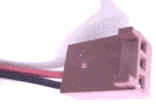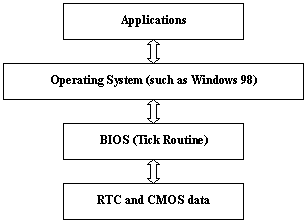 I did not install my Windows 98 the ACPI way. Can I still make use of functions like Suspend to Disk, Suspend to RAM, and so on?
I did not install my Windows 98 the ACPI way. Can I still make use of functions like Suspend to Disk, Suspend to RAM, and so on?
|
Don't worry.
Just go through Device Manager -> System Device -> Advanced Power Management Support -> Properties -> Driver -> Update Driver -> Next -> Display a List of All Devices -> Show All Hardware
Choose 'Advanced Configuration and Power Interface (ACPI). Then system will request for the original Win 98 CD-ROM. Restart the system and you'll be in ACPI mode of Win 98.
|
 Hardware Monitoring Utility reports my system does not support it. Why? The CPU fan has been connected to the 3-pin fan connector.
Hardware Monitoring Utility reports my system does not support it. Why? The CPU fan has been connected to the 3-pin fan connector.
|
Some recently available CPU fans have 3-pin connectors, but there are only two wires (red and black, see figure below) for powering the fan, the extra wire for sensing speed is missing. In this condition the CPU fan speed cannot be monitored.

|
 Does my Atric motherboard work with IrDA devices?
Does my Atric motherboard work with IrDA devices?
|
|
Yes, all Atric motherboards with IrDA connector onboard have been tested with IrDA adapters for data transmission. Atric itself does not sell IrDA adapters, but they are easily available at PC shops everywhere, please ask your retailer or distributor for more details.
|
 There is memory conflict on my AGP graphic card in Windows 95 Device Manager. Why?
There is memory conflict on my AGP graphic card in Windows 95 Device Manager. Why?
|
|
Windows 95 does not fully support AGP as Windows 98 does. The memory conflict in Win95 Device Manager -> Display Adapter -> Properties -> Resource can be regarded as a recognition problem, and would not lead to system malfunction.
|
 Q: What is Y2K problem?
Q: What is Y2K problem?
|
Y2K is basically a problem of the identification of year code. To save storage space, traditional software uses two digits for year identification. For example, 98 for 1998 and 99 for 1999, but 00 will be confused with 1900 and 2000.
There is a RTC circuit (Real Time Clock) in conjunction with 128 bytes CMOS RAM data in the chipset of motherboard. RTC has only two digits and CMOS has another 2 digits. Unfortunately, this circuitĄ¯s behavior is like this, 1997--> 1998 --> 1999 --> 1900, that means it may have Y2K problem. Below is a diagram of how application works with OS, BIOS and RTC. In order to keep best compatibility, in PC industrial. there is a rule that application must call OS to get service and OS must call BIOS, and then only BIOS is allowed to access hardware (RTC) directly.

There is a Tick Routine (goes alive around every 50m sec) in BIOS to keep record date/time information. For normal Award BIOS, this Tick Routine does not update CMOS every time because the access of CMOS is very slow and it will degrade system performance. The Tick Routine of Atric BIOS has 4 digits for year coding, as long as application and operating system follow the rule to get date/time information, there will be no Y2K problem (NSTLĄ¯s test program is doing so). But unfortunately, we found there is test program (such as Checkit 98) accesses RTC/CMOS directly. To ensure risk free, Atric BIOS team implements a selection option in CMOS setup, allows Tick Routine to update CMOS. The coding of this routine has been well taken care to minimize system performance loss.
|
 I heard that AGP slot may share an IRQ with some other devices. Is there any conflict? Anything I have to pay attention to?
I heard that AGP slot may share an IRQ with some other devices. Is there any conflict? Anything I have to pay attention to?
|
|
In many cases INT routings of the AGP slot and the first PCI slot are performed in the same way, that's why if both cards in these two slots have to take an IRQ there's possibly a negative effect on system performance. But if IRQ sharing has been considered in designing drivers for both devices, the system will still run smoothly - faster or slower, depending on how often the AGP card and the device on PCI slot 1 request an interrupt at the same time. Fortunately, AGP cards that require no IRQ are not rarely seen. Please avoid non-IRQ-sharing cards on these two slots.
|
 How to connect a USB device to my computer?
How to connect a USB device to my computer?
|
Most Atric motherboards have USB ports which allow you to connect USB devices directly. To connect extra USB devices to the USB connectors on board, you need an extra cable shown below. It is easily available in computer stores anywhere as after-market parts. Connect the black end to the USB connector on your motherboard, and screw the metal bracket to one expansion slot of the computer housing. Then you'll find two sockets on the back of the housing to plug in USB device connectors.

|
 The Hardware Monitoring Utility keeps reporting abnormal CPU temperature, voltage, etc., but the system seems working fine. Is there anything I have to check? Or should I call a technician?
The Hardware Monitoring Utility keeps reporting abnormal CPU temperature, voltage, etc., but the system seems working fine. Is there anything I have to check? Or should I call a technician?
|
Before you call a technician or have the board sent back for repairing, there're some point that deserve your attention:
- Is the CPU fan efficient enough? If not, the CPU temperature might go higher than expected.
- Some CPU fans will generate much noise, which may interfere with the temperature and voltage signals meant to be read by the A/D converter onboard. Under such circumstaces the Hardware Monitoring Utility will give incorrect statistics. Fans coming with boxed CPUs usually produce less noise.
|
 How can I benefit from the Ultra DMA 33 feature provided by Windows 98? Do I have to purchase some new hardware?
How can I benefit from the Ultra DMA 33 feature provided by Windows 98? Do I have to purchase some new hardware?
|
The Ultra DMA 33 mode makes use of both rising and falling edges of IDE command signal. That's why the data transfer rate is two times as fast as that of PIO PIO Mode 4, in which only the rising edge will be used.
As you can see, there is great advantage to transfer data through IDE channels in UDMA mode, so no wonder more and more IDE device makers are catching up with this trend: as a technology leader, Atric have already had this feature implemented on its IDE controller.
To make the most use of the UDMA function of Windows 98 as well as the hardware (hard drives), please first check if your motherboard BIOS and chipsets support this transfer mode; we suggest you always use the most updated revision of BIOS. If you are not so sure, please contact the manufacturer for detail. For the latest BIOS revision of Atric motherboards, please visit our Download Center or call your nearest dealer.
|
 Why do systems with Western Digital 1.6GB HDD fail to boot?
Why do systems with Western Digital 1.6GB HDD fail to boot?
|
|
Some large capacity HDDs require extra delay time to start up after power on. To resolve failure to boot problem, you may extend the delay time by configuring the Power-on Delay parameter under the BIOS Advanced Setup.
|
 What is the function of the PS/2 mouse connector header?
What is the function of the PS/2 mouse connector header?
|
|
The PS/2 mouse connector header on the system board enables the system to support a PS/2 mouse. However, you need to install a PS/2 mouse bracket that contains the PS/2 mouse port.
To enable the PS/2 mouse functions of the system, set the PS/2 Mouse Function parameter in the BIOS Advanced Setup to "ENABLED" and make sure that you set the proper jumper on the system board.
|
 Why will the system BIOS assign an IRQ to the PCI VGA card?
Why will the system BIOS assign an IRQ to the PCI VGA card?
|
|
Based on the PCI/PnP specification, system BIOS will automatically assign an IRQ to each PCI add-on card detected. If you do not want BIOS to assign an IRQ to the installed PCI VGA card, enter the BIOS PCI/PnP Setup and set the specific PCI slot IRQ Priority to "None".
|
 Why does the system fail to go into suspend mode under Win95?
Why does the system fail to go into suspend mode under Win95?
|
|
This problem may be caused by your CD-ROM settings. The CD-ROM Auto Insert Notification of Win95 is default enabled, the system will continue to monitor your CD-ROM, auto-execute application when a CD diskette is loaded, and prevents the system from entering into suspend mode. To resolve this, go into Control Panel, Device Manager, CD-ROM, Setting, and disable the "Auto Insert Notification" function.
|
 How can I read the CPU stepping information?
How can I read the CPU stepping information?
|
|
The CPUID utility is capable of reporting CPU information, model and stepping information. You can download it from Intel's homepage.
|
 Which version of the Windows '95 that I am using?
Which version of the Windows '95 that I am using?
|
You may determine the version of Windows '95 by the following steps.
1. Double click "System" in "Control Panel".
2. Click "General".
3. Look for "System" heading & refer to following,
4.00.950 Windows 95
4.00.950A Windows 95 + Service Pack or OEM Service Release 1
4.00.950B OEM Service Release 2 or OEM Service Release 2.1
|
 What is the meaning of AWARD BIOS beep code?
What is the meaning of AWARD BIOS beep code?
|
There are two kinds of beep codes in BIOS.
A single long beep followed by three short beeps:
This code indicates that a video error has occurred and the BIOS cannot initialize the video screen to display any additional information.
A single long beep repeatedly:
This other code indicates that your DRAM error has occurred.
|

